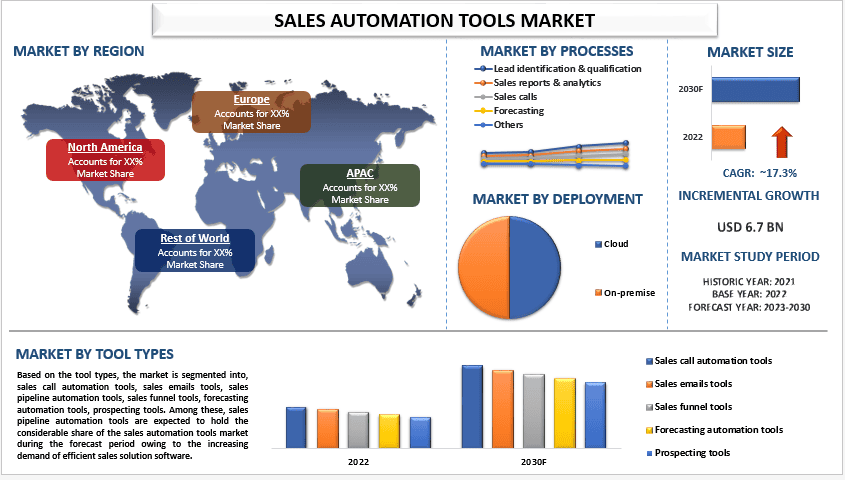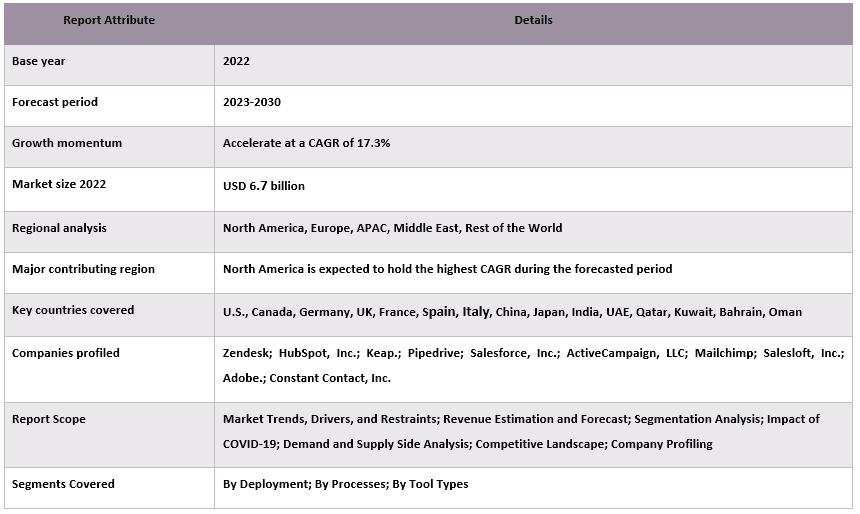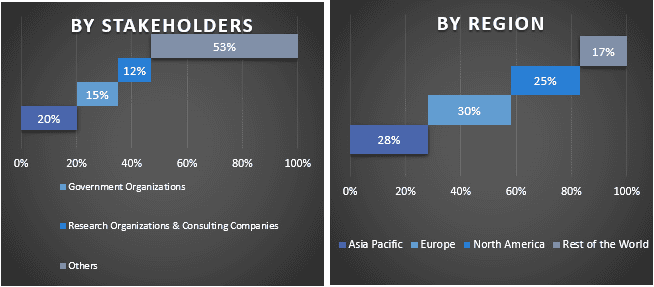- Home
- About Us
- Industry
- Services
- Reading
- Contact Us
Sales Automation Tools Market: Current Analysis and Forecast (2023-2030)
Emphasis on Deployment (cloud, on-premise); Processes (lead identification & qualification, sales reports & analytics, sales calls, forecasting, others {talent management, quota setting, order management, follow-up communication, pipeline management}); Tool Types (sales call automation tools, sales emails tools, sales pipeline automation tools, sales funnel tools, forecasting automation tools, prospecting tools); Region/Country.

The sales automation tools market was valued at USD 6.7 billion in 2022 & is expected to grow at a strong CAGR of 17.3% during the forecast year i.e. 2023-2030. This is because sales automation tools address the modern challenges of sales processes, leverage technology to optimize performance, and empower businesses to meet customer expectations more effectively. The continuous evolution of technology is accelerating the sales automation tools market. Sales automation tools are software applications or platforms designed to streamline and automate various aspects of the sales process, allowing sales teams to work more efficiently, close deals faster, and increase overall productivity. These tools utilize technology to automate repetitive tasks, manage customer interactions, and provide valuable insights to help sales representatives focus on high-value activities.
Some of the major players operating in the market include Zendesk; HubSpot, Inc.; Keap.; Pipedrive; Salesforce, Inc.; ActiveCampaign, LLC; Mailchimp; Salesloft, Inc.; Adobe.; Constant Contact, Inc.
Insights Presented in the Report
“Amongst deployment, the cloud segment captured the majority share of the sales automation tools market in 2022.”
Based on deployment, the market is bifurcated into cloud and on-premise. Among these, the cloud segment is expected to hold a larger share of sales automation tools market during the forecast period as it offers significant advantages like accessibility, flexibility, and scalability over traditional on-premises solutions. Moreover, cloud-based sales automation tools often require lower upfront costs compared to on-premises solutions. Additionally, the service provider typically handles ongoing maintenance, updates, and support, reducing the burden on the organization’s IT team. Therefore, all these factors together are fueling the growth of this segment in the sales automation tools market.
“Amongst processes, the lead identification & qualification segment captured the majority share of the sales automation tools market in 2022.”
Based on processes, the market is segmented lead identification & qualification, sales reports & analytics, sales calls, forecasting, and others. The lead identification segment is expected to hold a considerable share of the sales automation tools market during the forecast period to gain a competitive edge. Companies that adopt sales automation tools for lead identification and qualification are observed to hold a considerable position in the market. They can respond to leads faster, offer a more personalized experience, and have a higher likelihood of converting leads into customers than competitors relying on traditional, manual processes. Therefore, many organizations are adopting the sales automation tools, which is accelerating this segment in the sales automation tools market.
“North America is the largest growing region in sales automation tools market in 2022.”
North America is estimated to hold the most significant share of the market. The main driver behind the region’s market growth is the rising investments made by major organizations in sales automation. Moreover, in the region, the market is experiencing growth due to the close relationship with major players and easy access to AI-based sales force automation solutions.
Sales Automation Tools Market Report Coverage

Reasons to buy this report:
- The study includes market sizing and forecasting analysis validated by authenticated key industry experts.
- The report presents a quick review of overall industry performance at one glance.
- The report covers an in-depth analysis of prominent industry peers with a primary focus on key business financials, product portfolios, expansion strategies, and recent developments.
- Detailed examination of drivers, restraints, key trends, and opportunities prevailing in the industry.
- The study comprehensively covers the market across different segments.
- Deep dive regional level analysis of the industry.
Customization Options:
The global Sales Automation Tools market can further be customized as per the requirement or any other market segment. Besides this, UMI understands that you may have your own business needs, hence feel free to contact us to get a report that completely suits your requirements.
Table of Content
Research Methodology for the Sales Automation Tools Market Analysis
(2023-2030)
Analyzing the historical market, estimating the current market, and forecasting the future market of the global sales automation tools market were the three major steps undertaken to create and analyze the adoption of sales automation tools in major regions globally. Exhaustive secondary research was conducted to collect the historical market numbers and estimate the current market size. Secondly, to validate these insights, numerous findings and assumptions were taken into consideration. Moreover, exhaustive primary interviews were also conducted with industry experts across the value chain of global sales automation tools market. Post assumption and validation of market numbers through primary interviews, we employed a top-down/bottom-up approach to forecasting the complete market size. Thereafter, market breakdown and data triangulation methods were adopted to estimate and analyze the market size of segments and sub-segments of the industry pertains to. Detailed methodology is explained below:
Analysis of Historical Market Size
Step 1: In-Depth Study of Secondary Sources:
Detail secondary study was conducted to obtain the historical market size of sales automation tools market through company internal sources such as annual reports & financial statements, performance presentations, press releases, etc., and external sources including journals, news & articles, government publications, competitor publications, sector reports, third-party database, and other credible publications.
Step 2: Market Segmentation:
After obtaining the historical market size of sales automation tools market, we conducted a detailed secondary analysis to gather historical market insights and share for different segments & sub-segments for major regions. Major segments are included in the report deployment, processes, tool types Further country-level analyses were conducted to evaluate the overall adoption of testing models in that region.
Step 3: Factor Analysis:
After acquiring the historical market size of different segments and sub-segments, we conducted a detailed factor analysis to estimate the current market size of sales automation tools market. Further, we conducted factor analysis using dependent and independent variables such as deployment, processes, tool types A thorough analysis was conducted of demand and supply-side scenarios considering top partnerships, mergers and acquisitions, business expansion, and product launches in the Sales Automation Tools market sector across the globe.
Current Market Size Estimate & Forecast
Current Market Sizing: Based on actionable insights from the above 3 steps, we arrived at the current market size, key players in the global sales automation tools market, and market shares of the segments. All the required percentage shares split, and market breakdowns were determined using the above-mentioned secondary approach and were verified through primary interviews.
Estimation & Forecasting: For market estimation and forecast, weights were assigned to different factors, including drivers & trends, restraints, and opportunities available for the stakeholders. After analyzing these factors, relevant forecasting techniques i.e., the top-down/bottom-up approach, were applied to arrive at the market forecast for 2030 for different segments and sub-segments across the major markets globally. The research methodology adopted to estimate the market size encompasses:
- The industry’s market size, in terms of revenue (USD) and the adoption rate of sales automation tools market across the major markets domestically
- All percentage shares, splits, and breakdowns of market segments and sub-segments.
- Key players in the global sales automation tools market in terms of products offered. Also, the growth strategies adopted by these players to compete in the fast-growing market
Market Size and Share Validation
Primary Research: In-depth interviews were conducted with the Key Opinion Leaders (KOLs) including Top Level Executives (CXO/VPs, Sales Head, Marketing Head, Operational Head, Regional Head, Country Head, etc.) across major regions. Primary research findings were then summarized, and statistical analysis was performed to prove the stated hypothesis. Inputs from primary research were consolidated with secondary findings, hence turning information into actionable insights.
Split of Primary Participants in Different Regions

Market Engineering
The data triangulation technique was employed to complete the overall market estimation and to arrive at precise statistical numbers for each segment and sub-segment of the global sales automation tools market. Data was split into several segments & sub-segments post studying various parameters and trends in the areas of the deployment, processes, tool types in the global sales automation tools market.
The main objective of the Global Sales Automation Tools Market Study
The current & future market trends of the global sales automation tools market were pinpointed in the study. Investors can gain strategic insights to base their discretion for investments on the qualitative and quantitative analysis performed in the study. Current and future market trends determined the overall attractiveness of the market at a regional level, providing a platform for the industrial participant to exploit the untapped market to benefit from a first-mover advantage. Other quantitative goals of the studies include:
- Analyze the current and forecast market size of the sales automation tools market in terms of value (USD). Also, analyze the current and forecast market size of different segments and sub-segments.
- Segments in the study include areas of the deployment, processes, tool types.
- Define and analysis of the regulatory framework for the sales automation tools.
- Analyze the value chain involved with the presence of various intermediaries, along with analyzing customer and competitor behaviors of the industry.
- Analyze the current and forecast market size of the sales automation tools market for the major region.
- Major countries of regions studied in the report include Asia Pacific, Europe, North America, and the Rest of the World
- Company profiles of the sales automation tools market and the growth strategies adopted by the market players to sustain in the fast-growing market.
- Deep dive regional level analysis of the industry
Related Reports
Customers who bought this item also bought










